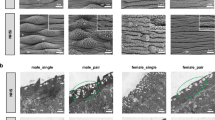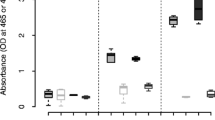Abstract
The schistosome parasite, Trichobilharzia ocellata, nearly completely inhibits the reproductive activity of its intermediate host, Lymnaea stagnalis. The synthetic activity of albumen glands of infected snails at day 35 postinfection (p.i.) is only 1% of the control value. The parasite acts by humoral means. We tested the hypothesis that (a) specific humoral agent(s) is (are) involved and refer to this (these) agent(s) as schistosomin. The presence of schistosomin in the hemolymph of infected snails was investigated by using galactogen synthesis in albumen glands as an in vitro bioassay. The synthetic activity of albumen glands of noninfected snails decreased by about 50% during a 1-h incubation in the hemolymph of infected snails. This inhibition is attributed to schistosomin. Based on these results, with the present bioassay schistosomin appears in the hemolymph between days 28–36 p.i. onwards. Schistosomin is heat-stable (100‡ C) and pronase-sensitive, and therefore it might have a peptide nature. Schistosomin suppresses the stimulating action of the female, gonadotrophic dorsal body hormone at relatively low doses, which suggests that it may compete with this hormone for the same receptors. The development of two other bioassays for schistosomin in our laboratory is discussed.
Similar content being viewed by others
References
De Jong-Brink M, Elsaadany MM, Boer HH, Joosse J (1986) Influence of trematode parasites upon the reproductive activity of their intermediate hosts, freshwater snails. In: Porchet M, Dhainaut A, Strambi A (eds) Advances in invertebrate reproduction. Elsevier Science Publishers BV, Amsterdam New York, pp 163–172
De Jong-Brink M, Elsaadany MM, Boer HH (1987a) Schistosomin, an antagonist of calfluxin. Exp Parasitol (in press)
De Jong-Brink M, Elsaadany MM, Boer HH (1987b) The parasite Trichobilharzia ocellata interferes with the endocrine control of female reproduction of its host Lymnaea stagnalis. Exp Parasitol (in press)
De With ND, Van der Wilt GJ, Van der Schors RC (1983) Studies on the constancy of the value of the ionic product Ca2+×CO3 2− in the hemolymph of the freshwater snail Lymnaea stagnalis. In: Westbroek P, De Jong EW (eds) Biomineralization and biological metal accumulation. Reidel, Dordrecht, pp 149–153
Dictus WJAG, De Jong-Brink M, Boer HH (1987) A neuropeptide (calfluxin) is involved in the influx of calcium into mitochondria of the albumen gland of the freshwater snail Lymnaea stagnalis. Gen Comp Endocrinol 65:439–450
Dische Z (1930) über einige neue charakteristische Farbreaktionen der ThymonukleinsÄure und eine Mikromethode zur Bestimmung derselben in tierischen Organen mit Hilfe dieser Reaktionen. Mikrochim Acta 8:4–32
Geraerts WPM, Van Leeuwen JPT, Nuyt K, De With ND (1981) Cardioactive peptides of the CNS of the pulmonate snail Lymnaea stagnalis. Experientia 37:1168–1169
Geraerts WPM, Ter Maat A, Vreugdenhil E (1987) The peptidergic neuroendocrine control of egg-laying behavior in Aplysia and Lymnaea. In: Laufer H, Downer R (eds) Invertebrate endocrinology. Alan Liss Inc, New York, vol 2, pp 377–468
Goudsmit EM (1975) Neurosecretory stimulation of galactogen synthesis within the Helix pomatia albumen gland during organ culture. J Exp Zool 191:193–198
Joosse J, Geraerts WPM (1983) Endocrinology. In: Saleuddin ASM, Wilbur KM (eds) The Mollusca. Academic Press, New York, vol 4, part I, pp 317–406
Joosse J, Van Elk R (1986) Trichobilharzia ocellata: Physiological characterization of giant growth, glycogen depletion, and absence of reproductive activity in the intermediate snail host, Lymnaea stagnalis. Exp Parasitol 62:1–13
Lever J, Bekius R (1965) On the presence of an external hemal pore in Lymnaea stagnalis. L. Experientia 21:1–4
Roubos EW (1984) Cytobiology of the ovulation neurohormone producing neuroendocrine caudo-dorsal cells of Lymnaea stagnalis. Int Rev Cytol 89:295–346
Sluiters JF (1981) Development of Trichobilharzia ocellata in Lymnaea stagnalis and the effects on the reproductive system of the host. Z Parasitenkd 64:303–319
Sluiters JF, Dogterom GE (1984) The effect of infection of Lymnaea stagnalis with Trichobilharzia ocellata on the presence of, and reactivity to the ovulation hormone of the host. Z Parasitenkd 70:485–489
Sluiters JF, Geraerts WPM (1984) Effects of elevated haemolymph levels of the female gonadotropic dorsal body hormone on the cercarial production of Trichobilharzia ocellata in Lymnaea stagnalis. Z Parasitenkd 70:477–484
Sluiters JF, Brussaard-Wüst CM, Meuleman EA (1980) The relationship between miracidial dose, production of cercariae and reproductive activity of the host in the combination Trichobilharzia ocellata and Lymnaea stagnalis. Z Parasitenkd 63:13–26
Sluiters JF, Roubos EW, Joosse J (1984) Increased activity of the female gonadotropic hormone producing dorsal bodies in Lymnaea stagnalis infected with Trichobilharzia ocellata. Z Parasitenkd 70:67–72
Wijdenes J, Van Elk R, Joosse J (1983) Effects of two gonadotropic hormones on polysaccharide synthesis in the albumen gland of Lymnaea stagnalis, studied with the organ culture technique. Gen Comp Endocrinol 51:263–271
Winer BJ (1971) Statistical principles in experimental design. McGraw-Hill, New York
Author information
Authors and Affiliations
Rights and permissions
About this article
Cite this article
Joosse, J., van Elk, R., Mosselman, S. et al. Schistosomin: a pronase-sensitive agent in the hemolymph of Trichobilharzia ocellata-infected Lymnaea stagnalis inhibits the activity of albumen glands in vitro. Parasitol Res 74, 228–234 (1988). https://doi.org/10.1007/BF00539570
Accepted:
Issue Date:
DOI: https://doi.org/10.1007/BF00539570




